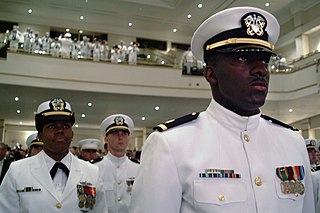In the United States Army and United States Air Force, a Gold Bar Recruiter (GBR) is a newly-commissioned second lieutenant who has been ordered to active duty on permissive Temporary Duty (PTDY) orders to assist the Professor of Military Science (or Aerospace Science, as applicable) and the Recruiting Operations Officer (ROO) with training and recruiting duties.

The United States Army (USA) is the land warfare service branch of the United States Armed Forces. It is one of the seven uniformed services of the United States, and is designated as the Army of the United States in the United States Constitution. As the oldest and most senior branch of the U.S. military in order of precedence, the modern U.S. Army has its roots in the Continental Army, which was formed to fight the American Revolutionary War (1775–1783)—before the United States of America was established as a country. After the Revolutionary War, the Congress of the Confederation created the United States Army on 3 June 1784 to replace the disbanded Continental Army. The United States Army considers itself descended from the Continental Army, and dates its institutional inception from the origin of that armed force in 1775.

The United States Air Force (USAF) is the aerial and space warfare service branch of the United States Armed Forces. It is one of the five branches of the United States Armed Forces, and one of the seven American uniformed services. Initially formed as a part of the United States Army on 1 August 1907, the USAF was established as a separate branch of the U.S. Armed Forces on 18 September 1947 with the passing of the National Security Act of 1947. It is the youngest branch of the U.S. Armed Forces, and the fourth in order of precedence. The USAF is the largest and most technologically advanced air force in the world. The Air Force articulates its core missions as air and space superiority, global integrated intelligence, surveillance, and reconnaissance, rapid global mobility, global strike, and command and control.
Active duty is a full-time occupation as part of a military force, as opposed to reserve duty. In the United Kingdom and the Commonwealth of Nations the equivalent term is active service.
This position typically begins 60 to 140 days before the BOLC B report date. A Gold Bar Recruiter adds a new perspective and energy to an ROTC battalion because of their recent familiarity with high school, college, and cadet life. If a "Gold-Bar" is in the National Guard, he/she may request extensions of their tour for up to 180 days providing their National Guard unit is willing to allow such an extension. Active duty officers may not receive such an extension, as their position at BOLC have already been reserved through their active duty units.
"Gold Bar" refers to the insignia of a second lieutenant in the United States Armed Forces: a single gold bar. The analogous position for the United States Navy and United States Marine Corps is Permissive Temporary Additional Duty (PTAD). [1]
The United States Armed Forces are the military forces of the United States of America. It consists of the Army, Marine Corps, Navy, Air Force, and Coast Guard. The President of the United States is the Commander-in-Chief of the Armed Forces and forms military policy with the Department of Defense (DoD) and Department of Homeland Security (DHS), both federal executive departments, acting as the principal organs by which military policy is carried out. All five armed services are among the seven uniformed services of the United States.

The United States Navy (USN) is the naval warfare service branch of the United States Armed Forces and one of the seven uniformed services of the United States. It is the largest and most capable navy in the world and it has been estimated that in terms of tonnage of its active battle fleet alone, it is larger than the next 13 navies combined, which includes 11 U.S. allies or partner nations. with the highest combined battle fleet tonnage and the world's largest aircraft carrier fleet, with eleven in service, and two new carriers under construction. With 319,421 personnel on active duty and 99,616 in the Ready Reserve, the Navy is the third largest of the service branches. It has 282 deployable combat vessels and more than 3,700 operational aircraft as of March 2018, making it the second-largest air force in the world, after the United States Air Force.

The United States Marine Corps (USMC), also referred to as the United States Marines or U.S. Marines, is a branch of the United States Armed Forces responsible for conducting expeditionary and amphibious operations with the United States Navy as well as the Army and Air Force. The U.S. Marine Corps is one of the four armed service branches in the U.S. Department of Defense (DoD) and one of the seven uniformed services of the United States.







